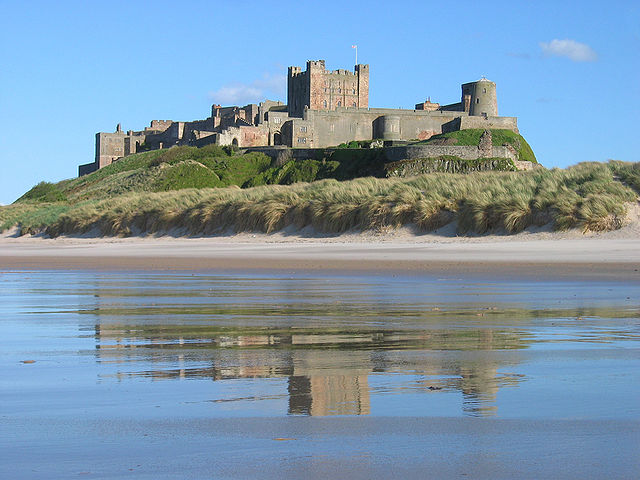Bamburgh Castle

Bamburgh Castle Photo - Michael Hanselmann -
Wikipedia - lic. under CC BY-SA 3.0

Castle Facts:
Location: Bamburgh, Northumberland, England.
Built: 12th-14th century.
Condition: Restored.
Ownership / Access: Lord Armstrong.
Opening times: Check their website for more info.
Price of admission: Check their website for more info.
Notes: Bamburgh Castle is located on the coast at Bamburgh in Northumberland, England. It is a Grade I listed building. Built on a dolerite outcrop, the location was previously home to a fort of the native Britons known as Din Guarie and may have been the capital of the British kingdom of the region (see Gododdin, Bryneich and Hen Ogledd) from the realm's foundation in c.420 until 547, the year of the first written reference to the castle. In that year the citadel was captured by the Anglo Saxon ruler Ida of Bernicia (Beornice) and became Ida's seat. It was briefly retaken by the Britons from his son Hussa during the war of 590 before being relieved later the same year.
His grandson passed it on to his wife Bebba, from whom the early name Bebbanburgh was derived. The Vikings destroyed the original fortification in 993.
The Normans built a new castle on the site, which forms the core of the present one. William II unsuccessfully besieged it in 1095 during a revolt supported by its owner, Robert de Mowbray, Earl of Northumbria. After Robert was captured, his wife continued the defence until coerced to surrender by the king's threat to blind her husband.
Bamburgh then became the property of the reigning English monarch. Henry II probably built the keep. As an important English outpost, the castle was the target of occasional raids from Scotland. In 1464 during the Wars of the Roses, it became the first castle in England to be defeated by artillery, at the end of a nine month siege by Richard Neville, 16th Earl of Warwick.
The Forster family of Northumberland provided the Crown with twelve successive governors of the castle for some 400 years until the Crown granted ownership to Sir John Forster. The family retained ownership until Sir William Forster (d. 1700) was posthumously declared bankrupt, and his estates, including the castle, were sold to Lord Crew, Bishop of Durham (husband of his sister Dorothy) under an Act of Parliament to settle the debts.The castle deteriorated but was restored by various owners during the 18th and 19th centuries. It was finally bought by the Victorian industrialist William Armstrong, who completed the restoration.
During the Second World War, the Royal Navy corvette HMS Bamborough Castle was named after it.The castle still belongs to the Armstrong family, and is opened to the public. It also hosts weddings and corporate events. It has been used as a film location since the 1920s, featuring in films such as Ivanhoe (1982), El Cid (1961), Mary, Queen of Scots (1971), Elizabeth (1998) and Macbeth.
How To Get To Bamburgh Castle (Map):
Bamburgh Castle Links:
Bamburgh Castle On WikipediaBamburgh Castle Guide from VisitNorthumberland.com
Bamburgh Castle � Map




